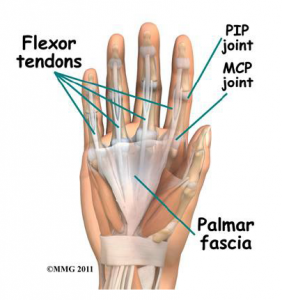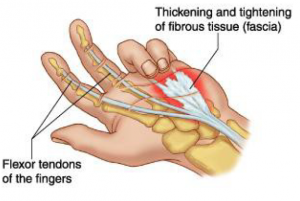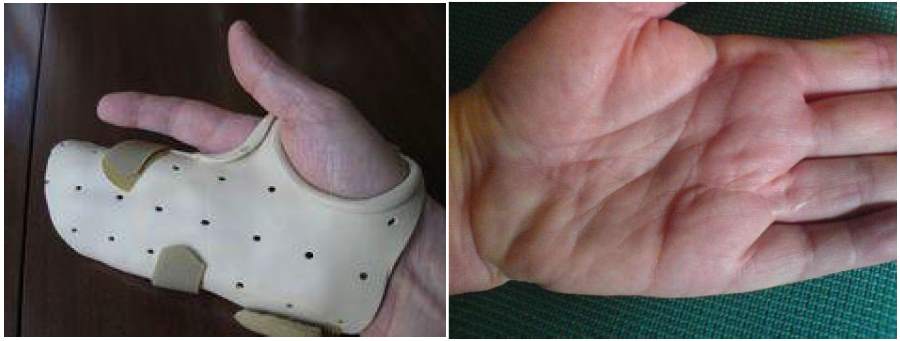Dupuytren’s Contracture
What is Dupuytren’s disease?
Dupuytren’s is not actually a disease, but rather it is a disorder. It is a benign (non-cancerous) proliferation of tissue in the hands that may cause a contracture. This contracture and proliferation start in the palmar fascia. This tissue in Dupuytren’s is made up of a disproportionate amount of type III collagen. Type III collagen is the collagen in wound healing and has contractile properties. The condition inherited, occurring mostly in white people of northern European descent. It has been called the “Viking Disease” for this reason.
Who gets Dupuytren’s?
The most common patient with Dupuytren’s is a white male in the 6th decade of life. It can occur, however, as early as the 3rd decade and in women. There is a strong genetic basis for Dupuytren’s. Some people get Dupuytren’s at an early age. When presenting young, Dupuytren’s tends to be aggressive.
Signs and Symptoms of Dupuytren’s
Dupuytren’s usually starts with a painless bump. Often, those affected notice a lump or a “pucker” of the skin in the palm. With time, these lumps may grow or proliferate causing a contracture. Dupuytren’s does not hurt unless one tries to stretch out a contracture. As contractures worsen, patients complain of the inability to place their hand in certain positions.
What are the treatments for Dupuytren’s contracture?
Many times, patients are told that they do not require surgery. A painless bump or a ‘cord’ does not need intervention if it does not cause a contracture.
Indications for intervention are a contracture of the metacarpophalangeal joint (knuckle) of 40° or any contracture of the proximal interphalangeal joint (the first joint of the finger). Surgery or enzyme injection can treat the contracture. Nothing will ‘cure’ a patient of Dupuytren’s. The decision for which type of treatment will be made depending on the level of the contracture and the severity of the contracture.
What is Xiaflex?
Xiaflex is clostridium toxin. It cleaves type III collagen and works well to disrupt cords and straighten fingers in those with Dupuytren’s contracture. It is a surgical procedure. While great results can occur with Xiaflex, most studies have shown it to be about equal long term in safety and recurrence to surgical treatment. More information can be found at https://www.xiaflex.com/.
Surgery for Dupuytren’s contracture.
Intervention is indicated when one can’t use the hand appropriately and if the PIP joint is affected. Surgery is performed as an outpatient. Many times, patients will require therapy after surgery. Surgical outcomes are affected by the degree of contracture and the length of time the contracture has been present. Surgical correction of a 90° PIP contracture averages 45° residual contracture long term. This is the reason for intervention before the contracture is severe.




